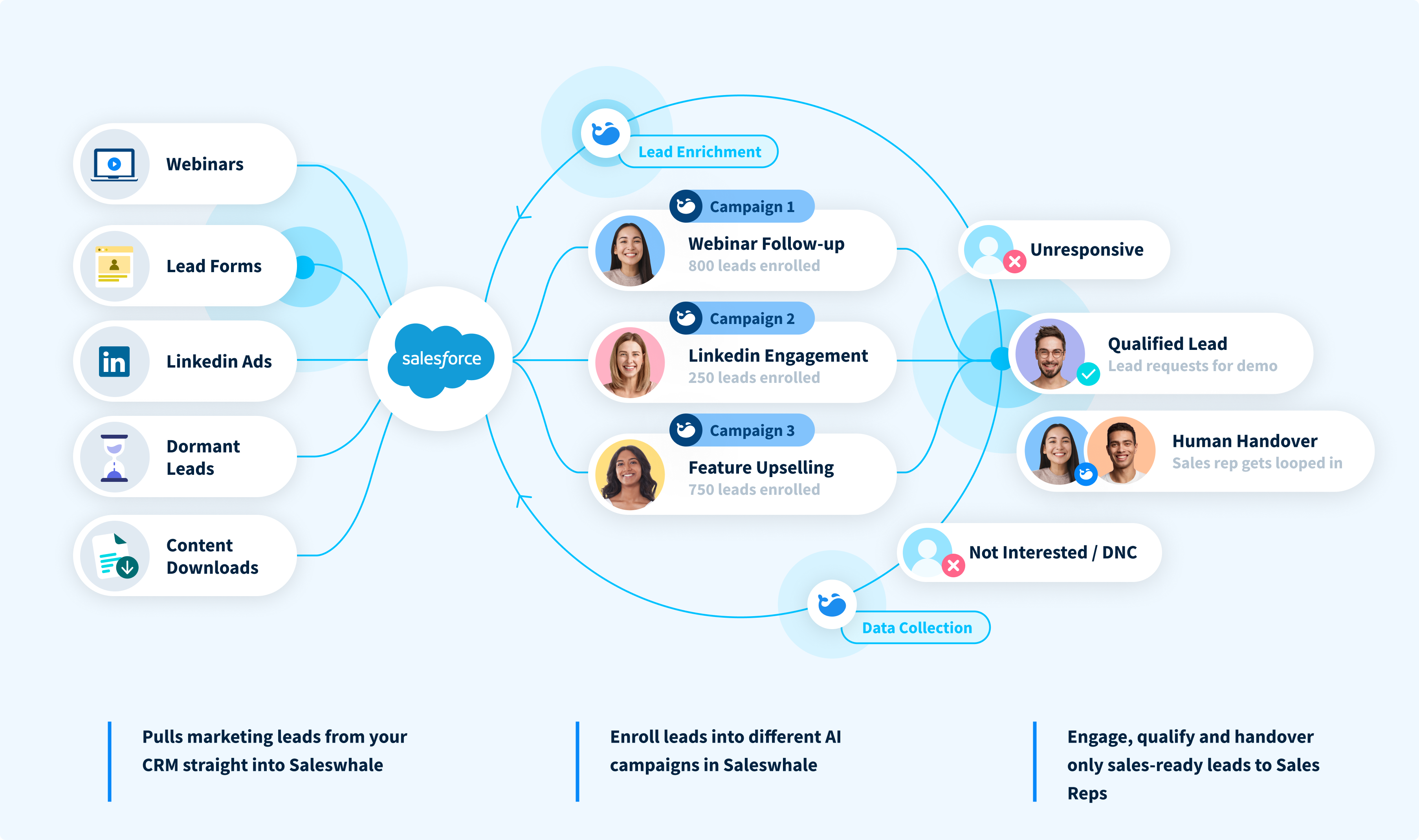Saleswhale Blog | 12 Min Read

Everyone’s had at least one experience that stops them from wanting to do business with a company.
For Scott Monty, former head of social media and digital communications at Ford, the deal breaker was this lead generation form:

The lead generation form that asked for too much, too soon
Ten compulsory fields. Including one requirement for “monthly ad spend”. All that in return for some information on “8 ultimate examples of omnichannel customer experiences."
That was Monty’s first encounter with the company. And also his last.
He wrote, “Not only is that overkill (i.e. greedy), but it puts the onus on the consumer rather than on the marketer. The marketer should be in the business of building interest and trust over time. In other words, it's lazy. BOOM. Greed and Sloth. Two deadly sins in one form.”
The average landing page conversion rate is 2.35%.
57% of people ignore cold calls.
Four in five people do not open the emails they get.
More and more people are installing ad blockers.
To top it all, just 3% of people trust marketers.
What’s with the backlash against marketing? Where have businesses gone wrong?


There is a lot of skepticism about gated content and lead generation forms
Let’s rewind back to what Monty said about the 10-field form. That form was bad because it demanded too much information from people, before trust and interest had even been established.
Therein lies the problem:
Many people associate marketing with spam. Think about it: when was the last time you were happy to see an email newsletter? Or got a ton of value from a whitepaper?
There’s a lot of bad marketing out there, unfortunately. And that’s because too many marketers forget to put the customer at the heart of their marketing.
They forget that leads are actual human beings. Humans with problems, humans searching for a solution, humans trying to get things done.
Marketing needs to pay attention to the needs of customers, not just the needs of the business. It’s time to build stronger trust and relationships with people. Here’s how:
Conversations?
You’re probably thinking that having conversations with your customers is something you already do. You’ve got several social media channels, where anyone can interact with your brand. You send your list an email newsletter every month. Perhaps you hold webinars that involve live Q and A.
But those are not the kinds of conversations we have in mind.
We’re talking about two-way conversations with each and every customer. Conversations that are geared towards helping them get what they need or make a purchase decision.
In other words, a real conversation. No different from a conversation you’d hold with a friendly and helpful person.
This is conversational marketing, which is different from the more conventional approaches that you are familiar with.
Conversational marketing is a customer-oriented marketing approach that uses conversations to build trust and relationships with customers over time. These conversations are personalized, one-to-one exchanges that can happen at scale.
When done right, conversational marketing can produce numerous business benefits:
With conversational marketing, you are also much less likely to lose focus on your customers and alienate them. You gain deeper insights into the problems your customers face and why they think your product can help them. Then you will know how to serve them better.
"There are literally millions of alive, flawed, human, passionate, influential and authentic conversations going on around you right now: isn’t it time you joined in?…Through the power of community, dialogue and partnership, marketing can be a conversation; a welcome guest in the homes, experiences and lives of our consumers.”~ Joseph Jaffe, Join the Conversation
How can we marketers be a welcome guest that people are willing to engage with?
It’s all about the way we hold conversations with our customers. In conversational marketing, conversations have these three key elements:
Many marketers use email to stay top-of-mind with their prospects and customers. For example, by sending email newsletters:

Do email newsletters like this count as having a personal conversation?
No.
This email newsletter was obviously sent to everyone on Tableau’s list. You can tell from the absence of a personalized greeting and the generic business email.
Now this is what a personalized email conversation looks like:

Notice that this email goes beyond including the receiver’s name in the salutation. Dolores's email acknowledged a specific action that Shane took—downloading an eBook. She then kept Shane engaged in the conversation by asking and reminding him about his availability for a call.
Why go through all that trouble to personalize? Because people are 137% times more likely to open emails that look like personal letters, and 129% times more likely to click through them, compared to a graphics-heavy email with generic ‘To’ and ‘From’ fields.
By the way, that email conversation between Dolores and Shane? Dolores is an AI. An AI sales assistant developed by us. Yes, you can use AI to personalize conversations, and you can learn more about AI sales assistants in part 4.
As marketers, we rely a lot on data from measuring and tracking our leads’ behaviors within our marketing funnel. We use that data to make inferences about our leads, such as whether they are qualified enough to pass on to sales.
But what if, instead of making educated best guesses, your leads told you what you want to know?
Conversational marketing lets you ask your leads about their interest in your business. Why did they contact you? How did they come across your product? What do they hope to achieve by doing business with you?
Conversational marketing also lets you expand on the conversations. You can ask follow up questions, receive more feedback, and find ways to help people. The insights you get will be deeper than if you had simply included your questions in a lead generation form.
There’s a limit to how many one-to-one conversations a small and busy human team can juggle, without burning out. Following up with every conversation over months is not the best use of your team’s time either.
That’s where technology comes in.
There are two main kinds of conversational marketing tools: chatbots and AI assistants. Both make it possible to have thousands of simultaneous conversations 24/7. No matter how many leads you have, you can be sure that they will receive prompt responses.
So, yes, it’s possible to have good customer experiences at scale!
G2 Crowd, the peer-to-peer business solutions review platform, defines conversational marketing tools as software that does the following:
We’ll cover two main types of conversational marketing platforms: business chatbots and AI assistants.
Let’s talk similarities first:
Both provide better customer experiences through scaleable and personalized two-way conversations. In terms of business benefits, both gather valuable qualitative customer feedback, which you can use to understand your customers and their needs better.
There are many differences between the two types, however, so you should not use one in place of another:
| Business chatbots | AI assistants | |
| Objectives | Drive website conversions and sign ups | Drive sales meetings and close deals |
| Department that uses it most | Customer service team | Sales team and marketing team |
| Medium | Websites and social media | |
| KPIs | Response time, helpfulness ratings | Qualified leads, sales meetings |
| Mechanics | Synchronous conversations | Asynchronous conversations |
| What they replace | Forms | Repetitive sales tasks and manual sales follow up |
| Notable examples | Drift, HubSpot | Saleswhale, Conversica |
General overview of the differences between business chatbots and AI assistants
Think of a business chatbot as a friendly and helpful customer service rep that you meet on a company’s website or social media. Her job is to give you quick answers to urgent questions or point you to the right person to speak to. You ask her a question, and she replies right away. If she had KPIs, they would be how fast and how well she takes care of your queries.
On the other hand, an AI assistant is more like a member of the sales or marketing team. You liaise with her over email, so her replies are not immediate. But she will always follow up on your queries promptly (she’s an AI after all!). Her job is to tell you more about a product and check if you are interested in purchasing. If you are keen and ready to buy, she will route you to a human sales rep to continue the conversation. Her KPIs are number of qualified leads and number of sales meetings.
So, when deciding between the two, think about which parts of your marketing funnel you need to optimize:
By this point, you're probably wondering how conversational marketing looks like in practice.
We at Saleswhale can answer that. Since 2016, we've implemented conversational marketing for over 100 mid-market and enterprise teams all over the world. Our AI sales assistants engage leads at scale, qualify them, and hand over the hot leads to sales.
Here are some of the main conversational marketing use cases we’ve come across:
Many businesses have a large backlog of “unripe” leads in their databases that no one knows what to do with.
These are the leads that never got to speak to sales for various reasons. Perhaps they weren't ready for a sales conversation when they first came across your product. Or maybe their lead scores were not high enough to warrant sales attention.
Don't ignore those unripe leads. They are a gold mine of sales opportunities!
Use an AI assistant to reconnect with every stale lead and uncover lost sales opportunities. For Randstad, using an AI assistant to re-engage their stale leads boosted their lead to meeting conversion rates by up to 79%.
Imagine sending an email to 2,000 leads, segmented across different verticals, to ask them if they would like to receive some content.
36% of them reply favorably (based on actual engagement statistics from Saleswhale, aggregated across millions of emails).
Now, your sales person has to manually attach relevant PDFs, across different verticals and segments, and email 720 prospects. This could take days, or even weeks.
Two days later, the sales person has to send a follow up email to ask if they have any questions, and if they want to jump on a call.
This is too tedious for a company to do at scale, and definitely not the best use of your sales team’s time.
But an AI sales assistant can handle this without dropping the ball.
95% of customers buy from companies who give them relevant content at each stage of the Buyer's Journey. Use an AI sales assistant to ensure that the leads who express interest in your content receive it.
According to EXHIBITOR, 98 percent of exhibitors collect sales leads at trade shows. However, less than 70 percent have any formalized plan or process in place for how those leads are followed up after the show.
Following up right away should be a top priority if you want to close many post-event sales. Did you know that the first vendor to email leads after events gets a three times higher click-to-open rate than the third vendor?
An AI sales assistant can help you start email conversations with your event leads at scale. It can also ask for referral leads and auto-engage them. Think about it: not every lead that visits your booth is a key decision maker. The AI sales assistant can ask the lead who the right person is. Once it gets this referral lead’s information, it captures and stores the new lead. Then it starts an email conversation with them.
Adopting conversational marketing isn’t – and shouldn’t be – a massive and radical endeavor. Conversational marketing works well with a lot of conventional marketing tactics and strategies. Just be clear about what you want your business and your customers to gain from the conversations.
Ultimately, adopting conversational marketing helps you to not lose sight of what’s truly important in business: your customers and their needs. Technology has made it possible to have great lead and customer relationships at scale. So start talking to your leads and customers today!
Interested in using AI to get more sales-ready leads? Request a demo of our AI sales assistant today!
Originally published on 14 December 2018, updated on 6 January 2020

Sign up for cutting edge ideas on conversational marketing, AI assistants and martech.

Saleswhale for Salesforce allows you to build powerful automated lead conversion workflows. This allows you to re-engage with your neglected marketing leads at...
19 APR 2021

Demand generation and marketing teams generate more leads at the top of the funnel than ever in this new digital-first world. Saleswhale helps ensure those...
1 MAR 2021

Marketers that focus on MQLs end up doing the wrong things in order to achieve the metrics. So I changed it.
16 JUN 2020

Conversica isn't the only player out there. Learn how Saleswhale and Exceed.ai compare and make an informed decision.
15 APR 2021
By providing your email you consent to allow Saleswhale to store and process the personal information submitted above to provide you the content requested.
You can unsubscribe at any time by clicking the link in the footer of our emails. For information about our privacy practices, please visit our privacy page.